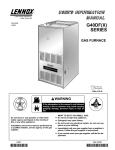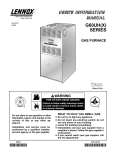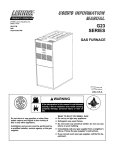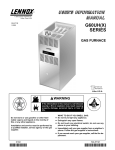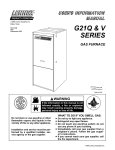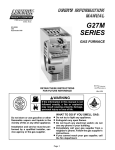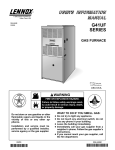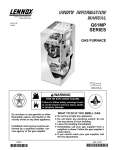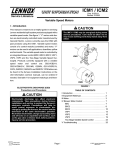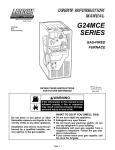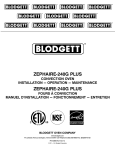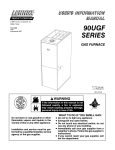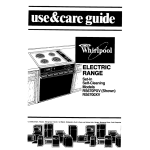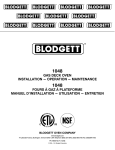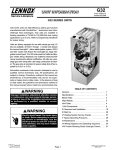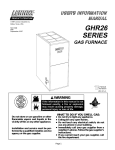Download Lennox International Inc. GHR32 User's Manual
Transcript
E2001 Lennox Industries Inc. Dallas, Texas, USA 504,392M 7/2001 Supersedes 504,117M GHR32 SERIES GAS FURNACE Litho U.S.A. WARNING If the information in this manual is not followed exactly, a fire or explosion may result causing property damage, personal injury or loss of life. Do not store or use gasoline or other flammable vapors and liquids in the vicinity of this or any other appliance. Installation and service must be perĆ formed by a qualified installer, service agency or the gas supplier. WHAT TO DO IF YOU SMELL GAS: D Do not try to light any appliance. D Extinguish any open flames. D Do not touch any electrical switch; do not use any phone in your building. D Immediately call your gas supplier from a neighbor's phone. Follow the gas suppliĆ er's instructions. D If you cannot reach your gas supplier, call the fire department. 07/01 *2P0701* 504,392M Page 1 *P504392M* GHR32 Parts Identification (Downflow Application Shown) CABINET TOP CAP BLOWER MOTOR 2-STAGE CONTROL BOARD BLOWER ACCESS DOOR CONTROL BOX DOOR INTERLOCK SWITCH COMBUSTION AIR PROVING (PRESSURE) SWITCH COMBUSTION AIR BLOWER DuralokPlusTM HEAT EXCHANGER ASSEMBLY GAS VALVE EXHAUST PIPE CONNECTION FRESH AIR INTAKE CONNECTION CONDENSATE TRAP CONNECTION HEATING ACCESS PANEL BURNER BOX BURNERS FLAME SIGHT GLASS Figure 1 Important Directions WARNING Product contains fiberglass wool. Disturbing the insulation in this product during installation, maintenance, or repair will expose you to fiberglass wool dust. Breathing this may cause lung cancer. (Fiberglass wool is known to the State of California to cause cancer.) Fiberglass wool may also cause respiratory, skin, and eye irritation. To reduce exposure to this substance or for further information, consult material safety data sheets available from address shown below, or contact your supervisor. Lennox Industries Inc. P.O. Box 799900 Dallas, TX 75379-9900 Page 2 1 - Keep the furnace area clear and free of combustible material, gasoline, and other flammable vapors and liquids. If installed in an insulated area, furnace must be kept free of insulating material. Insulating material may be combustible. 2 - DO NOT obstruct the air inlet. Unit must receive an unĆ obstructed flow of combustion and ventilating air. 3 - DO NOT store chlorine or fluorine products near unit or introduce these products into the combustion air. These products can cause furnace corrosion. 4 - DO NOT draw the return air from a room where another gas appliance (ie., a water heater) is installed. Even though this furnace draws its combusĆ tion air from outside of the structure, other gas apĆ pliances that share a utility room may not. When return air is drawn from a room, a negative pressure is created in the room. If a gas appliance is operating in a room with negative pressure, the flue products can be pulled back down the vent pipe and into the room. This reverse flow of the flue gas may result in incomplete combustion and the formation of carbon monoxide gas. This toxic gas might then be distributed through the house by the furĆ nace duct system. IMPORTANT Any additions, changes, or conversions required in order for the appliance to satisfactorily meet the application needs must be made by a Lennox serĆ vice technician using factory specified and apĆ proved parts. WARNING WARNING Carbon monoxide gas is invisible, odorless, and toxic. Your furnace is a gas appliance. It is critical that the gas supplied to the unit be completely burned to avoid the proĆ duction of carbon monoxide gas. Complete combustion of the gas requires, but is not limited to, correct gas pressure and gas flow rate, adequate combustion, air, and proper venting. Exposure to this gas can cause personal injury and even death to all occupants, including pets. Any item that is powered by or gives off heat from a combustion process (including lawn mowers, automobiles, and fireplaces) has the potential to produce carbon monoxide gas. Because of this, Lennox recommends the use of a carbon monoxĆ ide detector in your home, even if you do not own gas apĆ pliances. Reliable detectors are available at reasonable retail prices. Contact your independent Lennox dealer for more details about this investment in your safety. Your furnace is designed to meet standards set by naĆ tional agencies, and to operate safely when properly installed and maintained. However, the unit's perforĆ mance can be greatly impacted by the individual installaĆ tion and the operating environment. It is your responsibilĆ ity to ensure that this appliance is maintained. Proper maintenance is critical for your safety and the satisfactoĆ ry operation of the product. Lennox strongly recomĆ mends annual inspection and maintenance of this apĆ pliance. Contact your independent Lennox dealer for an inspection by a qualified service technician. If overheating occurs or if gas supply fails to shut off, shut off the manual gas valve to the appliance before shutting off electrical supply. Lighting Information & Operation WARNING If you do not follow these instructions exactly, a fire or explosion may result causing property damage, personal injury or death. BEFORE LIGHTING smell all around the appliance area for gas. Be sure to smell next to the floor because some gas is heavier than air and will settle on the floor. The unit is equipped with a gas control knob. Use only your hand to turn the gas control knob. Never use tools. If the knob will not push in or turn, do not try to repair it. Call a qualified service technician. Force or attempted repair may result in a fire or explosion. Placing the GHR32 furnace into operation: GHR32 units are equipped with a SureLightt ignition sysĆ tem. Do not attempt to manually light burners on these furĆ naces. Each time the thermostat calls for heat, the burnĆ ers will be automatically lit. The ignitor does not get hot when there is no call for heat on units with the SureLightt ignition system. Operating the Gas Valve (Figure 3 and 4) WARNING Do not use this furnace if any part has been underwaĆ ter. Immediately call a qualified service technician to inspect the furnace and to replace any part of the control system and any gas control which has been under water. 1 - STOP! Read the safety information at the beginning of this section. 2 - Set thermostat to its lowest setting. See figure 2. THERMOSTATS CAUTION Before attempting to perform any service or mainteĆ nance, turn the electrical power to unit OFF at the disconnect switch. Page 3 Figure 2 3 - Turn off all electrical power to the unit. 4 - This unit is equipped with an ignition device which auĆ tomatically lights the burners. Do not try to light it by hand. 5 - Remove the unit access panel. 6 - Turn gas valve knob to OFF. See figure 3. BACK FILTER CLIP CABINET HONEYWELL VR8205 Series Gas Valve FILTER SIDE FILTER CLIP DETAIL manifold pressure tap Press up on side filter clip to release filter (One on each side of cabinet) low fire adjusting screw (under cap) inlet pressure tap CABINET FILTER CLIP high fire adjusting screw (under cap) FILTER FILTER CLIP Figure 4 Gas Valve Shown In OFF Position Figure 3 7 - Wait five (5) minutes to clear out any gas. If you then smell gas, STOP! Immediately call your gas supplier from a neighbor's phone. Follow the gas supplier's inĆ structions. If you do not smell gas go to next step. 8 - Turn gas valve knob to ON. Do not force the knob. 9 - Replace the unit access panel. 10 - Turn on all electrical power to the unit. 11 - Set thermostat to desired setting. NOTE - When the unit is first started, steps 1 through 11 may need to be repeated to purge air from pilot line. 12 - If the appliance still will not operate, follow the instrucĆ tions Turning Off Gas to the Unit" and call your service technician or gas supplier. Turning Off Gas to the Unit 1 - Set thermostat to lowest setting. 2 - Turn off all the electrical power to unit if service is to be performed. 3 - Remove the unit access panel. 4 - Turn gas valve knob to OFF. Do not force the knob. 5 - Replace the unit access panel. Filters A filter must be in place anytime the unit is operating. The filter may be located in the unit or installed in a return air grille. Ask your dealer to show you the filter location. The filter should be inspected monthly and cleaned when necĆ essary to assure proper that the furnace operates properly. Filters used inside the GHR32 series units are available from Lennox and must be ordered separately. These foam filters may be cleaned for reuse. If the filters need to be reĆ placed, order Lennox part #31J81 for 14 X 25 inch filters for the GHR32Q-50, -75 and GHR32V-75. Number P-8-7831 is for 20 X 25 inch filters which are used with the GHR32Q, and V-100 and the GHR32Q-120 units. See figure 4 for reĆ moving the filter from the unit. Use the following procedure to clean the filter. Cleaning Filter 1 - Turn off electric power to the unit. 2 - Remove blower access panel. 3 - Remove filter by pressing side filter clips and pulling filter up and out. 4 - Clean filter with cold water and a mild soap. Direct waĆ ter through filter in the opposite direction of air flow. Remove all soap residue. 5 - Allow the filter to dry, then spray with Filter HandicoatĆ er (P-8-5069) prior to reinstallation. This spray is availĆ able from your Lennox dealer. 6 - Replace the filter in the blower compartment under the rear filter clip. Press on filter sides. The filter clips flex, allowing filter to snap into place. 7 - Replace the blower access panel. WARNING Blower door must be securely in place when blower and burners are operating. Gas fumes, which could contain carbon monoxide, can be drawn into living space resulting in personal injury or death. Seasonal Inspections A qualified service technician should inspect the complete system each season (heating and cooling). The following maintenance procedures should be conducted by a qualified service technician. Do not attempt to service the unit in any way. During a seasonal check the service technician will inspect the indoor blower and the burner flames along with the venting system. Venting System Annually (before heating season) inspect furnace venting system, heat exchanger, and burners for corrosion, deteriĆ oration, or deposits of debris. Remove any obstructions. Inspect furnace venting system to make sure it is in place, physically sound, and without holes or blockage. Vent conĆ nector must be in correct position, sloped upward and be physically sound without holes. Page 4 Inspect furnace return air duct connection to ensure duct is sealed to the furnace and terminates outside the space containing the furnace. Inspect the physical support of the furnace to guarantee that it is sound without sagging, cracks or gaps around base and it maintains seal between base and support. Inspect and clean the condensate traps and drain. Blower Check and clean blower wheel for any debris. Blower moĆ tor is pre-lubricated for extended bearing life. No further luĆ brication is needed. Burner Flame Set thermostat to call for heat. Allow unit to operate for a few minutes to establish normal burning conditions. Check burner flame. Flame should be predominantly blue and strong in appearance. CAUTION Periodically look through the flame sight glass to check the burner flame. Planned Service Contact your Lennox dealer for a periodic unit inspection by a qualified service technician. Service Reminder Call your Lennox service technician if unit is inoperative. Before calling, always check the following to be sure serĆ vice is required: 1 - Check that electrical disconnect switches are ON. 2 - Check room thermostat for proper setting. 3 - Replace any blown fuses or reset circuit breakers. 4 - Gas valve should be ON. 5 - Air filter should not be plugged limiting air flow. 6 - Is gas turned on at meter? 7 - Is manual main shut-off valve open? Safety Precautions If you discover any of the following, shut down your unit, and contact an independent Lennox dealer for an inspection by a qualified technician. D If you smell any unusual odors, your unit may be operatĆ ing improperly. For example, units can give off unfamilĆ iar odors if components are required to operate in abĆ normal conditions. D Look for visible signs of a malfunctioning unit. Examples include unusual amounts of condensate on windows inĆ side your house, visibly burnt components, or unusual accumulation of rust in the unit. D If you experience headache, nausea, fatigue, or dizziĆ ness, the cause could be exposure to carbon monoxide gas. This is often misdiagnosed as the flu because symptoms are similar. If you suffer from flu-like sympĆ toms that are exaggerated at home, but seem to subĆ side while you are away from the house, exposure to carbon monoxide could be the cause. Your vigilance may pay off in early detection of a problem before either personal injury or property damage occurs. Do not hesitate to contact a qualified service technician as an investment in your well being. D If you repeatedly hear any new or unfamiliar sounds while your unit is operating, there may be a problem. For example, poorly performing burners can produce unfaĆ miliar noises. You should expect a service technician to check the followĆ ing items during an annual inspection. Power to the unit must be shut off for the service technician's safety. Burners- Must be inspected for rust, dirt, or signs of water. Vent pipe - Must be inspected for dirt, damaged or sagging unsupported pipe, or disconnected joints. Unit appearance - Must be inspected for rust, dirt, signs of water, and burnt or damaged wires components. Blower access door - Must be properly in place and proĆ vide a seal between the return air and the room where the furnace is installed. Return air duct - Must be properly attached and provide an airtight seal to unit. Operating performance - Unit must be observed during operation to monitor proper performance of the unit and the vent system. Combustion gases - Flue products must be analyzed and compared to the unit specifications. Problems detected during the inspection may make it necĆ essary to temporarily shut down the furnace until the items can be repaired or replaced. Pay attention to your furnace. Situations can arise beĆ tween annual furnace inspections that may result in unsafe operation. For instance, items innocently stored next to the air inlet may obstruct the combustion air supply. This could cause incomplete combustion and the production of carĆ bon monoxide gas. Page 5





